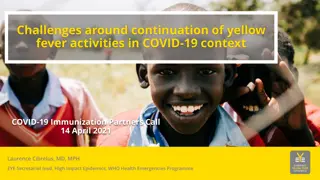Understanding Yellow Vein Mosaic Virus of Bhindi
Yellow Vein Mosaic Virus of Bhindi, also known as Okra Yellow Vein Mosaic, is a viral disease caused by the Begomovirus, affecting okra plants. The disease manifests through symptoms like vein-clearing and vein-chlorosis of leaves, leading to yellow network patterns on the leaves and stunted, malformed fruits. The causal organism, Yellow Vein Mosaic Virus, is transmitted by whiteflies and leaf hoppers. Efforts have been made to study the transmission and symptoms of this disease for effective management in okra cultivation.
Download Presentation

Please find below an Image/Link to download the presentation.
The content on the website is provided AS IS for your information and personal use only. It may not be sold, licensed, or shared on other websites without obtaining consent from the author. Download presentation by click this link. If you encounter any issues during the download, it is possible that the publisher has removed the file from their server.
E N D
Presentation Transcript
Yellow Vein Mosaic Virus Of Bhindi Presented By Dr. Madhuri M. Deshmukh Asst. Prof. Dayanand Science College Latur
Realm: Monodnaviria Kingdom: Shotokuvirae Phylum: Cressdnaviricota Class: Order: Family: Repensiviricetes Geplafuvirales Geminiviridae Genus: Begomovirus Species: Bhendi yellow vein mosaic virus
(Abelmoschus esculentus)Bhendi yellow vein mosaic virus (BYVMV) It is also called okra yellow vein mosaic (OYVMV) It is a viral disease caused by monopartite Begomovirus affecting okra plants. The disease was first reported in India country and further studies were extended by Uppal et al. (1940).
Symptoms of Yellow Vein Mosaic Disease: The typical symptoms are vein-clearing and vein-chlorosis of leaves. First of all, the clearing of small veins starts at various points near the leaf margins and thereafter the vein-clearing develops into vein- chlorosis. In later stages the leaves show very conspicuous yellow network of veins and the veins thickened particularly towards the lower surface of leaves.
Finally, the leaves become completely chlorotic leaving few green patches over the leaf surface. Usually, the fruits developed on diseased plants are reduced in size, malformed, and yellowish- green in appearance. Causal Organism - The Yellow Vein Mosaic of Bhindi is caused by Hibiscus virus 1 or yellow vein mosaic virus. Not much is known of the nature and properties of this virus.
Transmission Capoor and Varma (1950) have shown that the virus is not sap transmissible but under artificial conditions it can be transmitted by grafting which is not the natural means of propagation of this crop. They reported that the virus is transmitted in nature by white flies (Bemisia tabaci) and the okra leaf hopper, Empoasca devastans. The virus persists in the female white fly throughout its life if the insects is allowed to feed on diseased plants for 4-6 hours.
Bemesia tabaci (white fly) Bemisia tabaci flies Infected part of Plant
Yellow Vein Mosaic Disease Cycle: The virus survives in several weed hosts such as Croton sparsiflora, Malvastrum tricuspidatum, Ageratum sp., and a wild host, namely, Hibiscus tetraphyllous when the crop is absent. . Above mentioned weed hosts can be found generally growing along the roadsides. Yellow vein mosaic virus is not sap-transmissible in nature. It is readily transmitted by the whitefly, Bemisia tabaci. And Emposca devastans
The insect vector acquires the virus within 15-30 minutes, the viruses undergo an incubation period of seven hours within the body of the vector, and after that the vector inoculates them on crop plants. Once verulified, the vectors retain viruses in them and may infect host plants until they die. However, only 10 whiteflies per plant are required to give 100% infection. This disease causes 95% damage if host plant infected in early stage of their growth. The symptoms are less or not found in month of Feb and March.
Management of Yellow Vein Mosaic Disease: (i) All the weed hosts and wild Hibiscus plants growing in adjacent areas of the crop field should be up-rooted and destroyed. (ii) The diseased bhindi plants should be sorted out, collected, and burnt. The rotection of crop from insect vectors should be made by spraying suitable insecticides like Follidol (0.3%). This reduces the disease incidence considerably if the spraying is done during the initial stages of crop growth (within 20 days of germination)
If the disease incidence remains high. It has been recommended that the soil application of methyl phosphorodithioate (Furatox- IOG) at the rate of 15 kg/hac. followed by four foliar sprays of methyl dematon (metasystox ) at the rate of 0.03% at an interval of 15 days from the date of crop sowing reduces disease incidence by reducing whitefly population.
Use of resistant varieties should be preferred. However, Pusa Swani , Parbhani Kranti variety is resistant to some extent to this virus.























